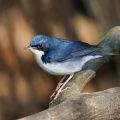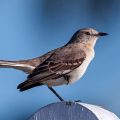In the vast world of insects, there are some creatures that captivate us with their peculiar appearance and intriguing behaviors. One such example is the mantidfly, a fascinating insect that often confuses people due to its name and appearance. Let’s delve into the mysterious world of mantidflies and uncover the secrets behind these enigmatic nerve-winged insects.
Contrary to popular belief, mantidflies are not a crossbreed between a praying mantis and a fly. They actually belong to an entirely different group of insects known as Neuroptera, or nerve-winged insects. This diverse group also includes lacewings, owlflies, and antlions, among others. With approximately 400 species worldwide and 13 species found in North America, mantidflies are relatively rare and intriguing creatures.
At first glance, one might mistake a mantidfly for a wasp or a praying mantis due to its unique appearance. These insects have long, slender bodies with elongated legs and wings that resemble those of a wasp. However, their resemblance to a praying mantis ends there. Mantidflies lack the characteristic raptorial front legs that praying mantises possess, which they use to catch and hold their prey. Furthermore, unlike wasps, mantidflies do not possess a stinger, despite their threatening behavior.
When threatened, mantidflies exhibit a peculiar defensive display. They flare out their wings, lean forward, and raise their abdomens into the air while continuously throbbing their abdomens in a stinging motion. This behavior aims to deter potential predators by creating an illusion of danger. Although they lack a stinger, mantidflies can also take flight swiftly to escape harm, showcasing their agility and adaptability in the face of danger.
The life cycle of a mantidfly is equally fascinating. It begins with an egg that is usually laid by the adult female on spider egg sacs. The larva hatches from the egg and feeds on the developing spider embryos within the sac. Once the larva reaches maturity, it spins a cocoon and pupates within the protective husk of the spider egg sac. This unique adaptation allows the mantidfly larva to utilize the spider’s resources for its own development. After the pupation period, the mantidfly emerges as an adult, showcasing its strange appearance and behavior.
Mantidflies are most diverse in regions located south of Wisconsin, but they can be found in various habitats across the globe. From forests to grasslands, these insects have adapted to a wide range of environments. However, due to their rarity and specific habitat requirements, encountering a mantidfly in the wild is no easy task.
Mantidflies are intriguing insects that continue to puzzle and captivate entomologists and nature enthusiasts alike. Despite their name and appearance, they are neither wasps nor praying mantises. Belonging to the Neuroptera group, they are unique in their own right. With their defensive displays, agile flight, and peculiar life cycle, mantidflies remind us of the endless wonders that await our exploration in the natural world. So, keep your eyes peeled and your curiosity ignited, for you never know when you might stumble upon one of these enigmatic nerve-winged insects.
Can A Mantidfly Sting?
Mantidflies cannot sting. While they may exhibit defensive behavior by flaring out their wings, leaning forward, and raising their abdomens in a stinging motion, they do not actually possess a stinger. This means that they are unable to deliver a venomous or painful sting like some other insects. Instead, mantidflies rely on these visual displays and their ability to fly readily to escape from perceived threats.

Is A Mantidfly A Wasp Or Mantis?
A mantidfly is neither a wasp nor a mantis. It belongs to a distinct group of insects known as the Neuroptera, or nerve-winged insects. This group encompasses various insects such as lacewings, owlflies, and antlions. Despite its name and appearance, the mantidfly is not related to wasps or mantises. It is important to note that the Neuroptera group consists of diverse insects with different characteristics and adaptations.
Mantidflies, specifically, are known for their unique morphology, resembling a combination of a mantis and a wasp. They have elongated bodies, long legs, and wings with intricate venation patterns. These features can sometimes lead to confusion with other insects. However, upon closer examination, it becomes clear that mantidflies are distinct from both wasps and mantises.
A mantidfly is a member of the Neuroptera group, which includes lacewings, owlflies, and antlions. While mantidflies may resemble wasps or mantises in appearance, they are not related to either of them.
Are Mantidflies Rare?
Mantidflies are indeed considered rare insects. Their rarity can be attributed to several factors, including their unique life cycle and specialized habitat requirements.
1. Life cycle: The life cycle of mantidflies is quite fascinating but also complex. After mating, the female mantidfly seeks out a spider egg sac and deposits her eggs inside it. The hatched larva then feeds on the spider eggs, eventually forming a cocoon within the egg sac. This pupal stage lasts for several weeks before the adult mantidfly emerges. The intricate nature of this life cycle, which requires specific conditions and timing, contributes to the rarity of mantidflies.
2. Habitat requirements: Mantidflies typically inhabit forested areas, especially those with diverse vegetation and abundant insect populations. They are known to prefer areas near streams or other water sources. These specific habitat requirements further limit their distribution and make it challenging to encounter mantidflies in the wild.
3. Low population density: Due to their specialized niche and specific requirements, mantidflies have relatively low population densities. They are not commonly observed or encountered by the average person. Being a rare species, mantidflies are not as widespread or abundant as some other insects.
4. Limited research: The rarity of mantidflies can also be attributed to the limited research and study conducted on these insects. Compared to more well-known insect species, mantidflies have received less attention from researchers and entomologists. This lack of knowledge and understanding contributes to the perception of mantidflies as rare creatures.
Mantidflies are considered rare due to their unique life cycle, specialized habitat requirements, low population densities, and limited research. Their intriguing biology and relative scarcity make them a fascinating subject for those interested in the world of insects.
Are Mantidflies Related To the Praying Mantis?
Mantidflies are not related to praying mantises. Although they share a similar name and appearance, mantidflies belong to a different taxonomic family called Mantispidae, while praying mantises belong to the family Mantidae. These two insect groups are not closely related and have distinct evolutionary lineages.
Here are some key points to understand the difference between mantidflies and praying mantises:
1. Taxonomy: Mantidflies belong to the family Mantispidae, which is part of the order Neuroptera, commonly known as lacewings. On the other hand, praying mantises belong to the family Mantidae, which is part of the order Mantodea.
2. Physical characteristics: While mantidflies and praying mantises may have a similar body shape and long, grasping forelimbs, there are noticeable differences in their appearance. Mantidflies have elongated bodies with a narrow waist, long antennae, and large compound eyes. Praying mantises, on the other hand, have a more robust body, triangular head, and distinct neck region.
3. Life cycle and behavior: Mantidflies have a unique life cycle that involves parasitism. The female mantidfly lays her eggs near the egg masses of spiders or wasps, and the larvae feed on the eggs and young of these hosts. Praying mantises, on the other hand, are known for their predatory behavior, capturing and feeding on a variety of insects and other small animals.
4. Evolutionary history: Mantidflies and praying mantises have evolved along separate evolutionary paths and belong to different insect orders. Mantidflies are believed to have originated during the Jurassic period, while praying mantises have a longer evolutionary history, dating back to the Cretaceous period.
Mantidflies and praying mantises are distinct insect groups with separate taxonomic classifications and evolutionary histories. Despite their similar appearance, they are not closely related and have different life cycles and behaviors.
Conclusion
The mantidfly is a fascinating and unique insect belonging to the Neuroptera group. Despite its name and appearance, it is neither a wasp nor a mantis. With over 400 species worldwide and 13 in North America, mantidflies are relatively rare. They have a peculiar life cycle that involves laying their eggs in spider egg husks, where the larvae develop and eventually transform into the adult mantidfly after pupation. These insects are known for their distinct defensive behavior, such as flaring out their wings and throbbing their abdomens when threatened. However, unlike their appearance suggests, mantidflies do not possess a stinger. Mantidflies are most diverse in regions south of Wisconsin, and they can readily fly to escape danger. the mantidfly is a remarkable creature that showcases the diversity and complexity of the insect world.












